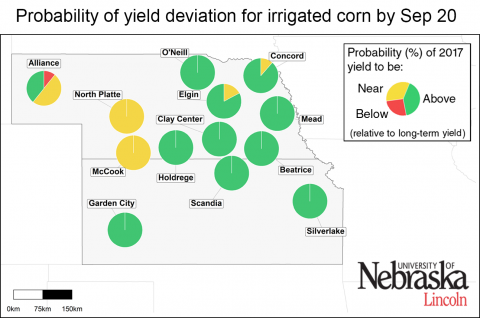Potential Reasons for Weakened Ear Shanks and Ear Loss
November 3, 2017
While sustained high winds for several days in late October was likely the final catalyst, a number of factors may have led up to increased ear drop in corn. This article looks at potential factors throughout the season that may have eventually led to a challenging harvest.
2017 Corn Yield Forecasts as of September 20
September 21, 2017
Crop modelers wrap up their forecasts of rainfed and irrigated corn yields across the Corn Belt for 2017, noting above-average yields for about 80% of the irrigated sites and more than 60% of the rainfed sites. Irrigated yields ranged from 11%-17% over long-term averages at those sites and rainfed yields at those sites were 13%-40% above average. View data for all the sites.
Plan Harvest to Deliver Soybeans at the Optimum Moisture
September 1, 2020
Most soybeans are harvested and delivered directly to an elevator. Soybeans delivered below or above 13% moisture—the elevator standard—lose potential profit. The economics illustrated here show how harvest timing can affect potential income.
2017 Corn Yield Forecasts as of August 30
September 1, 2017
Forecasts for end-of-season corn yields improved across much of the Corn Belt since the early August forecast. View crop stage and yield forecasts as well as weather data. In Nebraska predictions are for near to above average corn yields for most sites, except northeast and northwest sites.
Tell Us about Your Dicamba Use and Suspected Injury in Soybean
August 18, 2017
Nebraska Extension educators and specialists would like to hear from growers and agribusiness about their experiences with dicamba this season. Information can be shared via an online survey or by contacting them directly with the email provided.
2017 Corn Yield Forecasts as of Aug. 9
August 11, 2017
Corn yield forecasts for Nebraska sites indicate near-average to above average yields for most irrigated sites. There was much more yield variability for rainfed locations where three of the sites were forecast with a 50%-100% chance of below-normal yields and three were forecast for normal yields, while one was near average.
Scout Corn Fields for Kernel Set
August 4, 2017
Considering the day to day and week to week variability in weather we’ve experienced and the wide range of regional conditions across Nebraska this year, scouting fields for kernel set and overall condition may be more important than ever. Check out these corn reports from across the state.
Corn Disease Update: Southern Rust Increasing; Diplodia New to Nebraska
July 27, 2017
Warm, wet conditions across Nebraska the past two weeks created optimal conditions for crop diseases. This update looks at identification and management of three diseases in corn: southern rust, which is expanding in the state, bacterial leaf streak, and diplodia, which is new to Nebraska.









